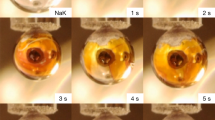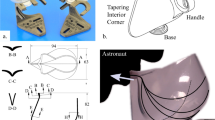This fluid can be used to create remarkable magnetic levitation and patterning effects.
Abstract
In magnetic levitation, a strong and spatially varying magnetic field exerts an upward force on a body that is sufficient to counteract its weight due to gravity. Here we show that this effect can be enhanced by immersing the body in cold oxygen gas, which provides a further strong and adjustable buoyancy force that allows a wide range of materials to be levitated in an open, unpressurized vessel. The buoyancy of magnetized liquid oxygen is sufficient to float even gold and platinum, suggesting that this technique could find application in mineral separation. An interesting periodic pattern is created on the surface of this pure elemental paramagnetic fluid.
Similar content being viewed by others
Main
Magnetic levitation occurs when the force on a diamagnetic body, due to an inhomogeneous magnetic field, is strong enough to balance the body's weight due to Earth's gravity1. The levitation force per unit volume of the body is given by (χv/µ0)BdB/dz, where χv is the volume magnetic susceptibility, µ0 is the permeability of free space, B is the magnetic field and dB/dz is the vertical field gradient. Immersing the body in a paramagnetic fluid, such as gaseous oxygen, enhances the levitation by providing buoyancy through the magneto–Archimedes effect. This technique has been used to levitate sodium chloride (density, 2.17 g ml−1) in a closed vessel containing oxygen at a pressure of 60 atmospheres (6 megapascals) at room temperature2.
We exploit two well-known laws of physics to levitate a wider range of diamagnetic materials, including crystals of quartz (2.65 g ml−1), potassium bromide (2.75 g ml−1) and diamond (3.51 g ml−1), in an open vessel of cold oxygen gas at atmospheric pressure. According to Boyle's law, at a fixed pressure the gas density varies inversely with temperature; Curie's law states that the paramagnetic susceptibility is also inversely proportional to the temperature. Near the boiling point of liquid oxygen (90 K), the magnetic buoyancy of oxygen gas is therefore about ten times stronger than at room temperature. This enhanced levitation is shown in Fig. 1a (and see movie in supplementary information).
a, Potassium chloride crystal levitating near the top of the magnet in an atmosphere of cold oxygen gas at about 200 K; BdB/dz = 1,400 T2 m−1. In the background is a liquid-oxygen membrane located at the centre of the magnet bore, where B = 17 T. The liquid's surface is decorated by an instability pattern. b, Dense objects floating in liquid oxygen in a glass Dewar vessel positioned just above the top of the magnet bore. Top to bottom: a silicon crystal, a gallium arsenide crystal, a £1 coin, a piece of lead and a gold coin. The field varies from 0.7 T (silicon) to 2 T (gold). c, A rectangular copper frame encloses a square-lattice instability pattern on the surface of liquid oxygen at 17 T. Several edge dislocations can be seen to the right. d, Detail showing an edge dislocation in the pattern.
Liquid oxygen provides still greater buoyancy, which is sufficient to float, at relatively low magnetic-field strengths, the densest diamagnetic objects and even weakly paramagnetic objects. Figure 1b shows a silicon crystal, a gallium arsenide crystal, a £1 coin, a piece of lead and a gold coin, all floating in the liquid oxygen. Each object floats at the point at which the local magneto–Archimedes force balances its weight, so its levitation position can be adjusted by changing the magnetic-field strength. This feature could be of use in mineral-separation technology.
We also noted the formation of a regular pattern of peaks on the surface of slowly boiling liquid oxygen; this pattern is held as a membrane at the centre of the magnet bore (Fig. 1a, c, d). The peaks arise from a combination of magnetic and surface-energy effects and have been observed before in synthetic ferrofluids3, but their appearance in a pure elemental paramagnetic liquid merits further investigation.
At high magnetic-field strengths (B > 13 tesla), a simple square-lattice structure, decorated by edge dislocations, can be formed inside a small rectangular frame. In weaker fields, hexagonal close-packed crystallites are evident. When the heat input to the liquid oxygen is sufficiently great, the fluid exhibits convection and turbulence, which causes complicated motion of the microcrystallites and dislocations (see supplementary information). This could provide an experimental test bed for models of crystal formation and dynamics.
References
Geim, A. K., Simon, M. D., Boamfa, M. I. & Heflinger, L. O. Nature 400, 323–324 (1999).
Ikezoe, Y., Hirota, N., Nakagawa, J. & Kitazawa, K. Nature 393, 749–750 (1998).
Cowley, M. D. & Rosensweig, R. E. J. Fluid Mech. 30, 671–688 (1967).
Author information
Authors and Affiliations
Corresponding author
Ethics declarations
Competing interests
The authors declare no competing financial interests.
Rights and permissions
About this article
Cite this article
Catherall, A., Eaves, L., King, P. et al. Floating gold in cryogenic oxygen. Nature 422, 579 (2003). https://doi.org/10.1038/422579a
Issue Date:
DOI: https://doi.org/10.1038/422579a
This article is cited by
-
Magnetic levitation using diamagnetism: Mechanism, applications and prospects
Science China Technological Sciences (2021)
-
Instability Pattern Formation in a Liquid Metal under High Magnetic Fields
Scientific Reports (2017)
-
Measurements of Thermal Conductivity and Thermal Diffusivity of Hen Egg-White Lysozyme Crystals and Its Solution Using the Transient Short Hot Wire Method
International Journal of Thermophysics (2017)
-
Facilities for Simulation of Microgravity in the ESA Ground-Based Facility Programme
Microgravity Science and Technology (2016)
-
The Inhibition of the Rayleigh-Taylor Instability by Rotation
Scientific Reports (2015)
Comments
By submitting a comment you agree to abide by our Terms and Community Guidelines. If you find something abusive or that does not comply with our terms or guidelines please flag it as inappropriate.




